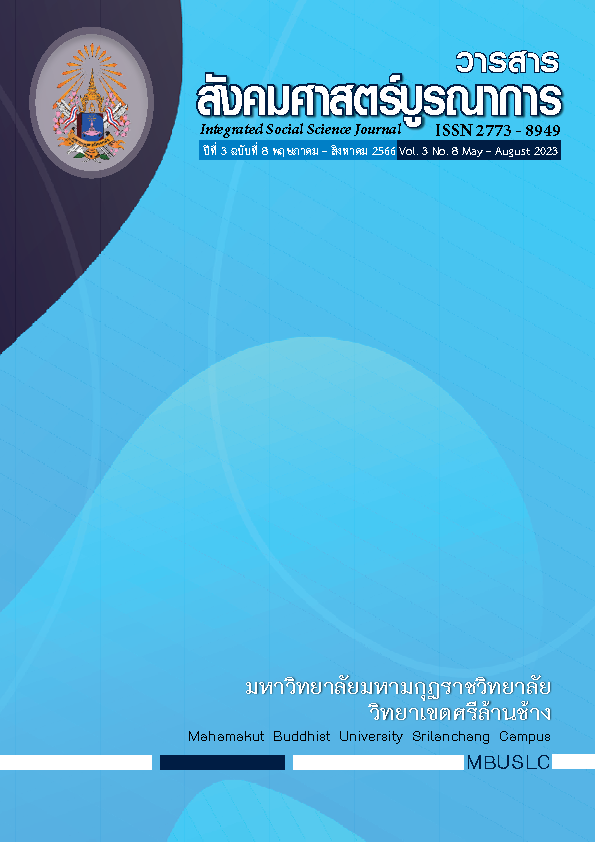THE CREATION OF WORK PERFORMANCE MOTIVATION IN ACCORDING WITH THE FOUR SANGAHAVATTHU OF EDUCATIONAL INSTITUTION ADMINISTRATORS UNDER THE OFFICE OF LOEI PRIMARY EDUCATIONAL SERVICE AREA 1
Main Article Content
Abstract
The objectives of this research were (1) to study the condition of the creation of work performance motivation of educational institution administrators under the Office of Loei Primary Educational Service Area 1, (2) to study the creation of the work performance motivation according to the Four Saṅgahavatthu of educational institution administrators under the Office of Loei Primary Educational Service Area 1, and (3) to propose a guideline to create the work performance motivation according to the Four Saṅgahavatthu of educational institution administrators under the Office of Loei Primary Educational Service Area 1. This study was carried out by means of mixed-method research. Data were collected by semi-structured interview method. The population used in this study were 142 school administrators from 142 schools under the Office of the Loei Primary Educational Service Area 1, 2022. 108 of those were selected as the samples based Krejcie and Morgan method and simple random sampling. Five key informants were interviewed to get more data. The research tool was a questionnaire with a reliability value of 0.878 and a semi-structured interview form.
The research results were as follows: 1. The overall condition of the creation of work performance motivation of educational institution administrators under the office of Loei Primary Educational Service Area 1 was statistically rated at the highest level. All studied aspects were at the same level. The highest mean was seen in the aspect of operational success, followed by the nature of work performed, advancement in work positions, acceptance, and responsibility.
- The overall mean of the creation of the work performance motivation according to the Four Saṅgahavatthu of educational institution administrators under the Office of Loei Primary Educational Service Area 1 was at the highest level. All studied aspects were the same. The highest mean was seen in the aspect of the creation of motivation in terms of job characteristics based on the Samānattatā, followed by the creation of motivation for acceptance and respect according to the Piyavācā, the creation of motivation for success in working according to the Dāna, the creation of motivation for advancement in job positions according to the Atthacariyā, and the creation of motivation for responsibility according to the Dāna.
- The guideline to create work performance motivation according to the Four Saṅgahavatthu of educational institution administrators under the Office of Loei Primary Educational Service Area 1 was that educational institutions should assess the efficiency or competency of teachers before assigning tasks to perform. After that, the results of the evaluation should be used to plan for assigning tasks to meet the teacher's aptitude with consistency. There should be a relationship in working together, and encouragement with polite words when the teachers complete the tasks. Administrators should provide knowledge and understanding, advise, promote, and assist teachers to solve problems in the operation of personnel. Educational institutions should be managed by providing an environment conducive to teaching and learning and adequately supporting equipment resources. Administrators should provide competent and dedicated teachers the opportunity to perform in higher positions. Educational institutions must be fair in evaluating performance for salary increases and allow teachers to continuously develop themselves. Administrators should delegate authority and decision-making to teachers in their work and should assign special tasks thoroughly so that teachers can fully demonstrate their abilities.
Article Details

This work is licensed under a Creative Commons Attribution-NonCommercial-NoDerivatives 4.0 International License.
บทความที่ได้รับการพิจารณาจากคณะกรรมการผู้ทรงคุณวุฒิและเผยแผ่ในวารสารฉบับนี้ เป็นทัศนคติและข้อคิดเห็นส่วนบุคคลของผู้เขียนแต่ละท่าน ไม่ถือว่าเป็นทัศนะคติและความรับผิดชอบ
ของบรรณาธิการ
บทความ ข้อมูล เนื้อหา รูปภาพ ฯลฯ ที่ได้รับการตีพิมพ์ในวารสารสังคมศาสตร์บูรณาการ ถือเป็นลิขสิทธิ์ของวารสารสังคมศาสตร์บูรณาการ หากบุคคลหรือหน่วยงานใดต้องการนำทั้งหมดหรือส่วนหนึ่งส่วนใดไปเผยแพร่ต่อหรือเพื่อกระทำการใด ๆ จะต้องได้รับอนุญาตเป็นลายลักอักษรจากวารสารสังคมศาสตร์บูรณาการ ก่อนเท่านั้น
References
กัญญนันทน์ ภัทร์สรสิริ. (2554). ปัจจัยที่มีอิทธิพลต่อประสิทธิภาพการทำงานของบุคลากร: กรณีศึกษาสำหรับสถาบันเทคโนโลยีปทุมวัน. กรุงเทพมหานคร: สาขาวิชาศึกษาทั่วไป คณะวิทยาศาสตร์และเทคโนโลยี สถาบันเทคโนโลยีปทุมวัน.
โชติกา ระโส. (2555). แรงจูงใจในการปฏิบัติงานของบุคลากรมหาวิทยาลัยราชภัฏนครสวรรค์. วิทยานิพนธ์ กศ.ม. (การอุดมศึกษา). กรุงเทพมหานคร: บัณฑิตวิทยาลัย มหาวิทยาลัยศรีนครินทรวิโรฒ
พระนุชิต นาคเสโน และ พระครูปริยัติวรเมธี (ทิพย์มณี). (2565). การสร้างแรงจูงใจเพื่อเพิ่มประสิทธิภาพในการปฏิบัติงานของบุคลากรตามหลักพุทธธรรม. วารสารพุทธนวัตกรรมและการจัดการ. 5(1). มกราคม - มิถุนายน 2565. หน้า 81 - 82.
ระบบบริการข้อมูลภาครัฐ Big DATA. (2565, 26 สิงหาคม). สํานักงานเขตพื้นที่การศึกษาประถมศึกษาเลย เขต 1. ออนไลน์. สืบค้นเมื่อ 26 สิงหาคม 2565 แหล่งสืบค้น https://bigdata.loei1.go.th/
สํานักงานเขตพื้นที่การศึกษาประถมศึกษาเลย เขต 1. (2565, 26 สิงหาคม). อัตลักษณ์องค์กร. ออนไลน์. สืบค้นเมื่อ 26 สิงหาคม 2565 แหล่งสืบค้น https://loei1.go.th/?page_id=88
สำนักงานเขตพื้นที่การศึกษาประถมศึกษาเลย เขต 1. (2563). รายงานผลการดำเนินงานประจำปีงบประมาณ พ.ศ. 2564. เลย: กลุ่มงานนโยบายและแผน สำนักงานเขตพื้นที่การศึกษาประถมศึกษาเลย เขต 1.
สุพานี สฤษฎ์วานิช. (2552). พฤติกรรมองค์การสมัยใหม่. พิมพ์ครั้งที่ 7. กรุงเทพมหานคร: โรงพิมพ์มหาวิทยาลัยธรรมศาสตร์.

